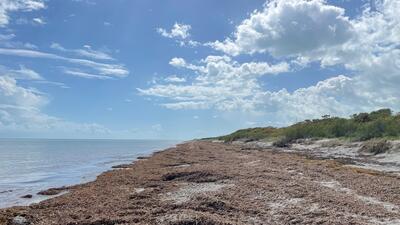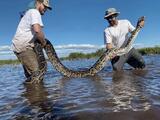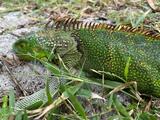Florida beaches face double threat: red tide and giant floating mass of seaweed

Florida beaches are under threat from all directions as residents and the travel industry brace for a double dose of toxic red tide on the west coast and a giant floating mass of sargasso seaweed off the east coast.
With Spring Break in full swing, one of the biggest holiday times of the year for students, the red algae bloom is already affecting beaches with dead fish washing up along the Gulf Coast, causing an ugly stench which can also cause respiratory problems. Spring breakers are a bit luckier on the east coast where the seaweed is slowly creeping across the Atlantic ocean and is not expected for another few weeks.
“You can already smell it. People are coughing and talking about the health effects (of red tide),” said Susan Glickman, a consultant with Florida Clinicians for Climate Action who lives near Tampa on the west coast of Florida. “The tourism industry is pretty good at cleaning the beaches, so you don’t see it so much. But it’s harder to get rid of the smell,” she told Univision.
Sargassum typically begins arriving in May and peaks in June and July. But already, the seaweed is starting to pile up on beaches in Florida’s Key West as well as in Mexico’s Cancun, Playa del Carmen and Tulum.
Six million tons of seaweed moving this way
Some beaches in South Florida get smaller doses of sargassum throughout the year, but nothing like what scientists say is expected this year as a 5,000-mile-wide area of patches of seaweed estimated to weigh six million tons is making its way into the Caribbean.
The latest sargassum bloom is the second largest ever recorded at this time of year, according to scientists, nearly twice the width of the entire United States, and is visible from space.
Despite being part of the natural ecosystem, the proportions of this sargassum island have alarmed experts, especially because of the speed at which it is growing.
Satellite imagery showed a big growth of sargassum approaching the Caribbean in January. “That’s what got people talking. They are concerned it is growing more than in the past,” said Josefina Olascoaga, a professor of Ocean Sciences at the University of Miami.
How much will reach the shores of Florida depends on the current and the wind patterns. “The sargasso is floating so it not only moves with the current, it can also be the wind,” said Olascoaga.
Each summer, the current carries the sargassum westwards from the Atlantic into the Caribbean to the coast of Mexico and Central America before looping back eastwards towards Florida on the Gulf Stream.
As it makes the loop, winds from the east could push it into the Gulf of Mexico or onto the beaches of south Florida. “It could be bad, but it may not. If the wind isn’t intense enough there won’t be so much on the beaches,” said Olascoaga.
The growth of sargassum began creating problems a little more than a decade ago and has mystified scientists. The first started landing on beaches in large amounts in Ghana in 2009, then in 2011 it struck the Caribbean region and Florida.
“There are many hypotheses,” said Olascoaga. In order to grow, the sargassum needs nutrients and scientists are looking at possible sources such as the Amazon river in Brazil and the Orinico in Venezuela, as well as dust from Africa being deposited in the ocean, or burning of land . “All this is the subject of investigation. We are looking at where the nutrients are from. At the moment we don’t know,” said Olascoaga.
Another theory is warmer ocean temperatures creating better conditions for growth, though Olascoaga noted that sargassum has traditionally grown well in cooler equatorial waters.
The Sargasso Sea is a vast patch of ocean with enormous island-like patches of large brown seaweed, a type of algae, that floats with the current often reaching the waters off the southeast coast, according to the National Oceanic and Atmospheric Administration (NOAA). As it degrades, it releases gases like hydrogen sulfide, which smells like rotten eggs and is harmful, especially for asthma sufferers.
Unlike other seaweeds that reproduce and begin life on the ocean floor, the Sargasso Sea is unique in that it harbors species of algae that floats around the ocean and reproduces vegetatively on the high seas. Sargassum provides a home to an amazing variety of marine species such as turtles, shrimp, crab and fish that depend on it for food and the lay their eggs.
Red tide on Florida's west coast
The red tide is a problem that has affected the west coast of Florida since the 1940s. The red tide algae, known as Karenia brevis, can deprive sea life of oxygen, producing a foul smell as dead marine animals wash ashore. The ocean breeze can carry a toxin released by the red tide algae ashore, which can cause health problems for people including coughing, irritated throat and itchy eyes, as well as difficulty breathing and asthma attacks.
The algae bloom occurs naturally, but scientists are looking into whether pollution is making the blooms worse. Storm surge from Hurricane Ian last year may also have caused more nutrients and algae to be pushed up from the sea floor to the surface.
“We’re seeing red tide all along southwest Florida and getting on-water reports of dead marine life,” according to the website of Captains for Clean Water (CCW), a Florida group which advocates for better state water mismanagement.
"The situation is improving consistently now but the concern is still there if we have an early wet season or we get big discharges from Lake Okeechobee," Chris Wittman, co-founder of CCW, told Univision, referring to the vast and highly polluted fresh water lake in the center of the state.
When the lake level is high, water is released into estuaries that flows into the Gulf of Mexico, carrying fertilizer from the sugar field south of the lake. A massive, 30-year restoration project is underway in the Everglades to restore the natural flow of water south, which it is hoped will alleviate the need to release water out of the lake into the gulf. "We can't do anything about hurricanes, but we can control our ability to send the water elsewhere," send Wittman.
In the presence of red tide, health officials advise not to swim in water near dead fish, especially if you have respiratory problems. Local residents living in beach areas are advised to close windows and run the air conditioner.
“There’s a lot of warnings about getting in the water,” said Glickman, who warns that climate change may be to blame. “Our ecosystems seem to be trying to tell us something. When we have increasingly warmer oceans that’s going to give breed grasses and bacteria than can harm our health,” she added. “We need to wake up and smell the sargassum.”



